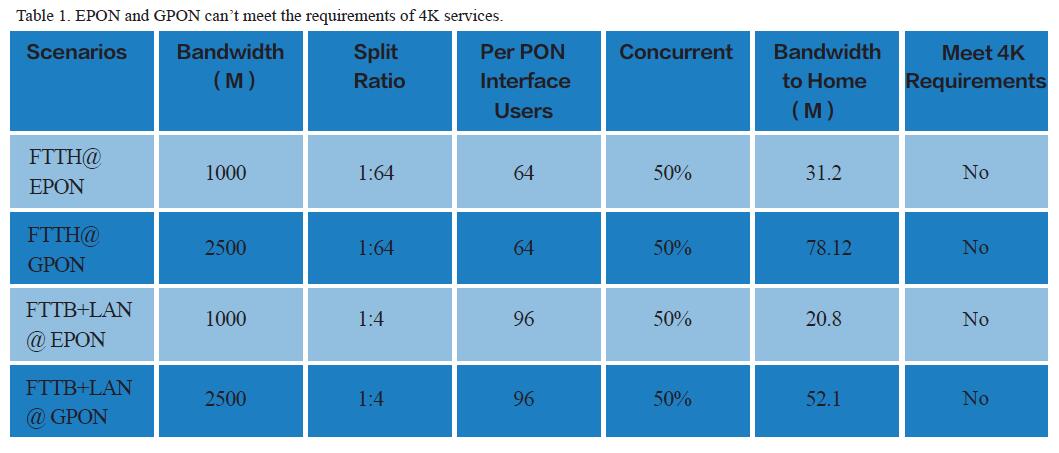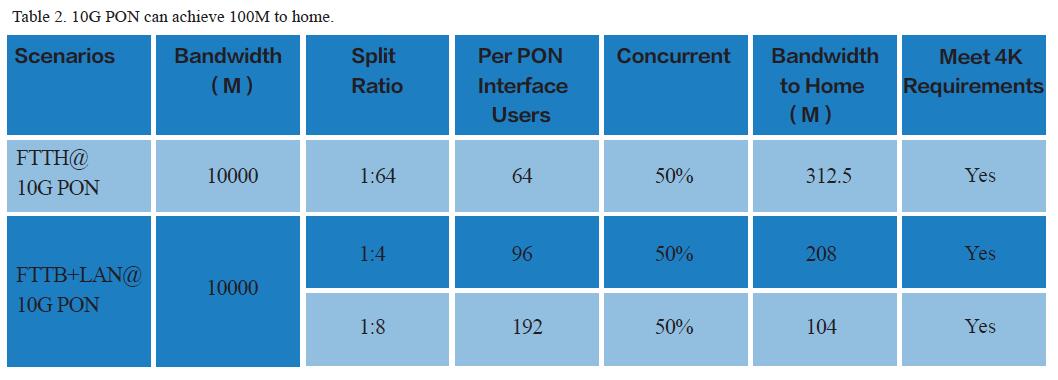10G PON: The Best Choice in the 4K Era
4K is a video service with 3840 × 2160 pixels. 4K standard has been defined by ITU-R Recommendation BT.2020 (ultra high definition television 4K and ultra high definition television 8K), which has been released by ITU in 2012. The resolution of 4K is fourfold as that of high definition TV (2K). In addition, the images of 4K are more smooth and colorful than that of HD. Therefore, 4K services enable the audience to see every detail of images and enjoy the unparallel visual experience.
4K industry has burgeoned in recent years. Now, it is booming in many countries. In the United States, Netflix was the first to launch video-on-demand services based on 4K technology. In Japan, where 4K has been viewed as a basic service of ICT sector, NexTV forum has been set up to promote 4K services. In Europe, Pay-TV operators, telecom operators, and multiple service operators (MSO) are working hard to prepare for 2016 World Cup broadcast with commercial 4K. What’s more, as the hardware technology of 4K has developed, mainstream vendors are supporting the 4K technology now, including chip, video interface standards, TV panels and terminal equipment. Obviously, 4K industry chain has already been created and developed.
4K brings huge opportunities for operators. Firstly, as a basic service, especially for families, video service has a massive user base. The development of 4K services drives FTTx network construction. Secondly, video service boasts a key source of network traffic consumption, and it helps operators gain the high ground of traffic. Finally, 4K services enable operators to build brand, increase revenue, boost appeal and strengthen user loyalty. In short, the operator who grasps 4K technology will stand out in the competitive market.
4K technology is not only an opportunity but also a challenge for the existing network. The capacity of a 4K video is up to tens of Gigabits, which is dozens of times that of ordinary video. The large-capacity video is challenging the storage and process performance of terminals. It is estimated that the required bandwidth for smooth playback of 4K video is 45M~100M. That means the bandwidth access to home should be upgraded to more than 100M, and the watch model should be transferred from download model to real-time online model, which set higher requirements for performance, delay and reliability of the access network. In addition, as 4K technology is gradually applied to video shooting, security, and online games, the uplink bandwidth will be increased, and the traffic model of upstream and downstream will be changed.
Therefore, the existing EPON and GPON technologies can’t meet the requirements of 4K services (Table 1). Take EPON as an example. As the common split ratio of FTTH@EPON is 1:64 and the concurrent radio is 50% in the existing network, the bandwidth access to home is 31.2M, which can’t realize 100M to home. In the FTTB+LAN@EPON scenario, there are 96 users per PON interface, and the concurrent radio is still 50%, the bandwidth access to home is about 20.8M, which is far from to meet the needs of 100M to home.

It is the same case with GPON. FTTH@GPON and FTTB+LAN@GPON are very difficult to implement 100M to home. In order to run 4K services smoothly, increase broadband speeds and upgrade the existing network have become key issues. Meanwhile, a technology with higher bandwidth, such as 10G PON, is required to support 4K services.
In 2009, IEEE issued IEEE802.3av as 10G EPON standard, which raises the downstream speed to 10 Gbps. In 2010, ITU-T issued XG-PON1 standard for G.987.x. The upstream bandwidth and downstream bandwidth are 2.5 Gbps and 10 Gbps respectively.
To meet the bandwidth requirement of high upstream scenarios, ITU-T issued a symmetric 10G PON (XGS-PON) protocol, which sets 10 Gbps data rates in both upstream and downstream directions. Over many years’ attentive efforts, a complete industry chain has been established on the base of 10G PON technology, and 10G PON has entered the commercial stage.
Due to its mature industrial chain and excellent performance, 10G PON has gradually become a mainstream technology of PON network. 10G PON is evolved from EPON/GPON technologies and it can be upgraded to 100M to home easily. By reusing ODN and deploying appropriate wavelength, 10G PON and 1G PON coexists with each other, which means operators can achieve network evolution smoothly. Moreover, 10G PON greatly reduces the cost for operators to popularize 100M and 1G.
In the FTTH@10G PON scenario, as the split ratios is 1:64 and the concurrent radio is 50%, the bandwidth access to home is up to 312M. In the FTTB+LAN@10G PON scenario, the bandwidth access to home is about 208M~104M. Therefore, 10G PON is the best choice in the 4K era (Table 2).

ZTE: A Pioneer of 4K and 10G PON Technologies
● Eight-port capacity and high density 10G PON cards, including 10G EPON cards and 10G GPON cards. All cards employ pluggable optical transceiver modules for on-demand configuration.
● Complies with G.987 and G.988 standards, transmits 1PPS+ToD signals to implements clock synchronization, and supports H-QoS (hierarchical QoS).
● Full range of ASIC terminal products, such as 10G PON MDUs, SFUs/HGUs and SFP ONUs, to meet various requirements in different scenarios.
● High-precision OTDR detection. ZTE’s build-in OTDR supports link detection without affecting optical lines and service quality.
● Unified network architecture, service distribution, O&M, and access regardless of transmission medium. By operating and managing FTTO, FTTdp and FTTB networks in a unified manner, ZTE’s 10G PON solution achieves network flatness and simplifies O&M.
● Eco-friendliness. ZTE’s 10G PON solution adopts multiple energy-saving measures, including port management, card electromechanical management, ONU energy-saving control, and smart low-power chips, to reduce overall power consumption.
● The first Combo solution in the industry. It combines GPON and XG-PON1 in an optical module, and reuses the existing ODN network to save space and simplify the complex routing and O&M.
● Evolve to NG-PON2 with low cost through wavelength stacking and bandwidth overlay.
ZTE’s 10G PON solution enables operators to transform their business successfully. It helps operators protect investments, enhance competitiveness, and improve brand influence.
4K technology is leading us into a splendid video era. By virtue of profound technology accumulation, ZTE’s 10G PON solution guarantees good user experience of 4K services, and contributes to the development of 4K technology.